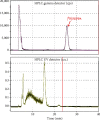Neuroinflammation in Low-Level PM2.5-Exposed Rats Illustrated by PET via an Improved Automated Produced [18F]FEPPA: A Feasibility Study
- PMID: 35903248
- PMCID: PMC9328187
- DOI: 10.1155/2022/1076444
Neuroinflammation in Low-Level PM2.5-Exposed Rats Illustrated by PET via an Improved Automated Produced [18F]FEPPA: A Feasibility Study
Abstract
Background: [18F]FEPPA is a potent TSPO imaging agent that has been found to be a potential tracer for imaging neuroinflammation. In order to fulfill the demand of this tracer for preclinical and clinical studies, we have developed a one-pot automated synthesis with simplified HPLC purification of this tracer, which was then used for PET imaging of neuroinflammation in fine particulate matter- (PM2.5-) exposed rats.
Results: Using this automated synthesis method, the RCY of the [18F]FEPPA was 38 ± 4% (n = 17, EOB) in a synthesis time of 83 ± 8 min from EOB. The radiochemical purity and molar activities were greater than 99% and 209 ± 138 GBq/μmol (EOS, n = 15), respectively. The quality of the [18F]FEPPA synthesized by this method met the U.S. Pharmacopoeia (USP) criteria. The stability test showed that the [18F]FEPPA was stable at 21 ± 2°C for up to 4 hr after the end of synthesis (EOS). Moreover, microPET imaging showed that increased tracer activity of [18F]FEPPA in the brain of PM2.5-exposed rats (n = 6) were higher than that of normal controls (n = 6) and regional-specific.
Conclusions: Using the improved semipreparative HPLC purification, [18F]FEPPA has been produced in high quantity, high quality, and high reproducibility and, for the first time, used for PET imaging the effects of PM2.5 in the rat brain. It is ready to be used for imaging inflammation in various clinical or preclinical studies, especially for nearby PET centers without cyclotrons.
Copyright © 2022 Mei-Fang Cheng et al.
Conflict of interest statement
The authors declare that they have no competing interests.
Figures






Similar articles
-
[18F]FEPPA a TSPO Radioligand: Optimized Radiosynthesis and Evaluation as a PET Radiotracer for Brain Inflammation in a Peripheral LPS-Injected Mouse Model.Molecules. 2018 Jun 7;23(6):1375. doi: 10.3390/molecules23061375. Molecules. 2018. PMID: 29875332 Free PMC article.
-
GMP-compliant fully automated radiosynthesis of [18F]FEPPA for PET/MRI imaging of regional brain TSPO expression.EJNMMI Res. 2021 Mar 16;11(1):26. doi: 10.1186/s13550-021-00768-9. EJNMMI Res. 2021. PMID: 33725191 Free PMC article.
-
An one-pot two-step automated synthesis of [18F]T807 injection, its biodistribution in mice and monkeys, and a preliminary study in humans.PLoS One. 2019 Jul 1;14(7):e0217384. doi: 10.1371/journal.pone.0217384. eCollection 2019. PLoS One. 2019. PMID: 31260447 Free PMC article.
-
TSPO expression in a Zika virus murine infection model as an imaging target for acute infection-induced neuroinflammation.Eur J Nucl Med Mol Imaging. 2023 Feb;50(3):742-755. doi: 10.1007/s00259-022-06019-w. Epub 2022 Nov 9. Eur J Nucl Med Mol Imaging. 2023. PMID: 36348095 Free PMC article.
-
Neuroinflammation in healthy aging: a PET study using a novel Translocator Protein 18kDa (TSPO) radioligand, [(18)F]-FEPPA.Neuroimage. 2014 Jan 1;84:868-75. doi: 10.1016/j.neuroimage.2013.09.021. Epub 2013 Sep 21. Neuroimage. 2014. PMID: 24064066 Free PMC article.
References
Publication types
MeSH terms
Substances
LinkOut - more resources
Full Text Sources
Miscellaneous
